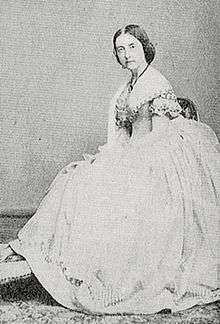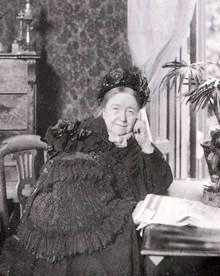Lotten von Kræmer
Charlotte "Lotten" Louise von Kræmer (6 August 1828, Stockholm – 23 December 1912, Stockholm) was a Swedish baroness, writer, poet, philanthropist and women's rights activist. She was the founder of the literary society Samfundet De Nio and, alongside Martina Bergman-Österberg, the main financier of the National Association for Women's Suffrage.


Biography
Lotten von Kræmer was the daughter of the governor of Uppsala County, Baron Robert Fredrik von Kræmer and Maria Charlotte (Lotten) Söderberg and the sister of the writer, scientist and politician Robert von Kraemer. She was raised in the governor's residence at the Uppsala Castle in Uppsala, and received private education from the professors of the Uppsala University.
She was a popular participator of the cultural and intellectual society life in Uppsala. Authors such as Geijer and Atterbom were acquainted with her parents, and Fredrika Bremer was a friend of her mother. She herself proved her talent in various artistic fields such as within literary evenings, dance during the balls and acting during the amateur theater, such as when she played the part of Jane Eyre, in which she was instructed by Elise Hwasser. In the summer of 1847, she visited Germany, Austria and Italy with her family. From 1847, however, her hearing slowly deteriorated as a consequence of scarlet fever, and she eventually became deaf. This ended her society life and affected her deeply. She was engaged to the conservative student Sten Johan Stenberg in 1855, but the engagement ended because of her deteriorating hearing and because he could not accept her radical ideas and her literary ambitions. She never married.
In 1880, her father died and she inherited a great fortune, which she is said to have managed very well. She moved to Stockholm, where she lived a more and more spartan life over the years and was regarded as an original. She spent a great deal of her fortune to finance various organisations of charity and reform of her choice.
Bibliography
- Dikter, 1863
- Hemresan, song, 1864
- Fantasi-klängväxter kring verklighets stam, 1865
- Tankar i religiösa ämnen, 1866
- Strid' svenskt original, 1869
- Ackorder (poems), 1870
- Bland skotska berg och sjöar, 1870
- "Tout pour la patrie" (poems), 1872
- Nya dikter, 1882
- Felicia: svensk familjedram i tre akter, 1882
- Sånger och bilder, 1886
- En kämpande ande: religiösa dikter, 1886
- Florence Nightingale: poesi, 1886
- Poesiens vandring (illustrated by Jenny Nyström), 1888
- Karins bröllop, novel, 1890
- Hermes och Diotima: skådespel i fem akter, 1892
- Den kämpande anden: religiösa väckelser och religiöst liv: några sånger och tidsbilder, 1892
- Hägringar och luftslott (poems), 1895
- Skogsblommor: idyller och ballader (poems), 1896
- Eterneller (poems), 1896
- Två dikter, 1896
- Till Ingeborg och andra dikter, 1897
- Fama: skådespel i tre akter, 1902
- Fragment jämte andra dikter, 1902
- Nästa gång - : berättelser och skisser, 1902
- Testamente, 1913
- Samlade skrifter (published by Samfundet De Nio, with a biography by John Landquist), 1918
Sources
| Wikimedia Commons has media related to Lotten von Kræmer. |